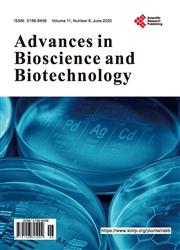Anti-Angiogenic and Anti-Metastatic Effects of Biogenic Silver Nanoparticles Synthesized Using Azadirachta indica
引用次数: 11
Abstract
Background: Nanotechnology symbolizes a broad discipline with enormous potential in cancer treatment bridging one of the bottlenecks of traditional approaches in cancer therapy which is an inability to deliver adequate quanti-ties of anti-cancer drugs to the tumor area. Studies on nanoparticles indicate their importance in cancer angiogenesis and metastasis. Aim: The present study assessed anti-angiogenesis and anti-metastatic effects of biogenic silver nanoparticles (AgNPs) synthesized from neem plant (Azadirachta indica). Methods: Chicken chorioallantoic membrane (CAM) and two-dimensional (2D) wound healing assays were used to study anti-angiogenic and an-ti-metastatic effects of the AgNPs respectively. Twenty-four fertilized eggs were divided into four groups: two biogenic AgNPs treatments at 100 µg/ml and 200 µg/ml; negative control (1% DMSO) and positive control (cyclo-phosphamide). 2D wound healing assay, DU145 human prostate cells were grown in Dulbecco’s Modified Eagle’s Medium supplemented with 10% Fetal Bovine Serum. Results: Biogenic AgNPs demonstrated anti-angiogenic effects in a dose-dependent manner in the parameters generated from the CAM images. Also, qRT-PCR revealed down-regulation of iNOS and VEGF genes. The 2-dimensional wound healing assay showed inhibition of migration and motility of the DU145 cells for the 72-hours of assessment. Conclusion: The present study postulates that the biogenic AgNPs can prevent angiogenesis by inactivation of VEGF-NO and VEGF/VEGF-R pathways while inhibiting cell migration and metastasis.印楝合成生物源银纳米颗粒的抗血管生成和抗转移作用
背景:纳米技术象征着一门广泛的学科,在癌症治疗方面具有巨大的潜力,它克服了传统癌症治疗方法的瓶颈之一,即无法将足够数量的抗癌药物输送到肿瘤区域。研究表明纳米颗粒在肿瘤血管生成和转移中的重要性。目的:研究印楝植物合成的生物源银纳米颗粒(AgNPs)的抗血管生成和抗转移作用。方法:采用鸡毛尿囊膜(CAM)和二维(2D)伤口愈合实验,分别研究AgNPs的抗血管生成和抗转移作用。24枚受精卵分为4组:100µg/ml和200µg/ml的AgNPs处理2组;阴性对照(1% DMSO)和阳性对照(环磷酰胺)。2D伤口愈合实验,DU145人前列腺细胞在添加10%胎牛血清的Dulbecco 's Modified Eagle 's培养基中生长。结果:生物源AgNPs在CAM图像生成的参数中显示出剂量依赖性的抗血管生成作用。qRT-PCR结果显示iNOS和VEGF基因下调。二维伤口愈合实验显示,在72小时的评估中,DU145细胞的迁移和运动受到抑制。结论:本研究推测生物源性AgNPs通过抑制VEGF- no和VEGF/VEGF- r通路的失活,抑制细胞的迁移和转移,从而阻止血管生成。
本文章由计算机程序翻译,如有差异,请以英文原文为准。
求助全文
约1分钟内获得全文
求助全文

 求助内容:
求助内容: 应助结果提醒方式:
应助结果提醒方式:


